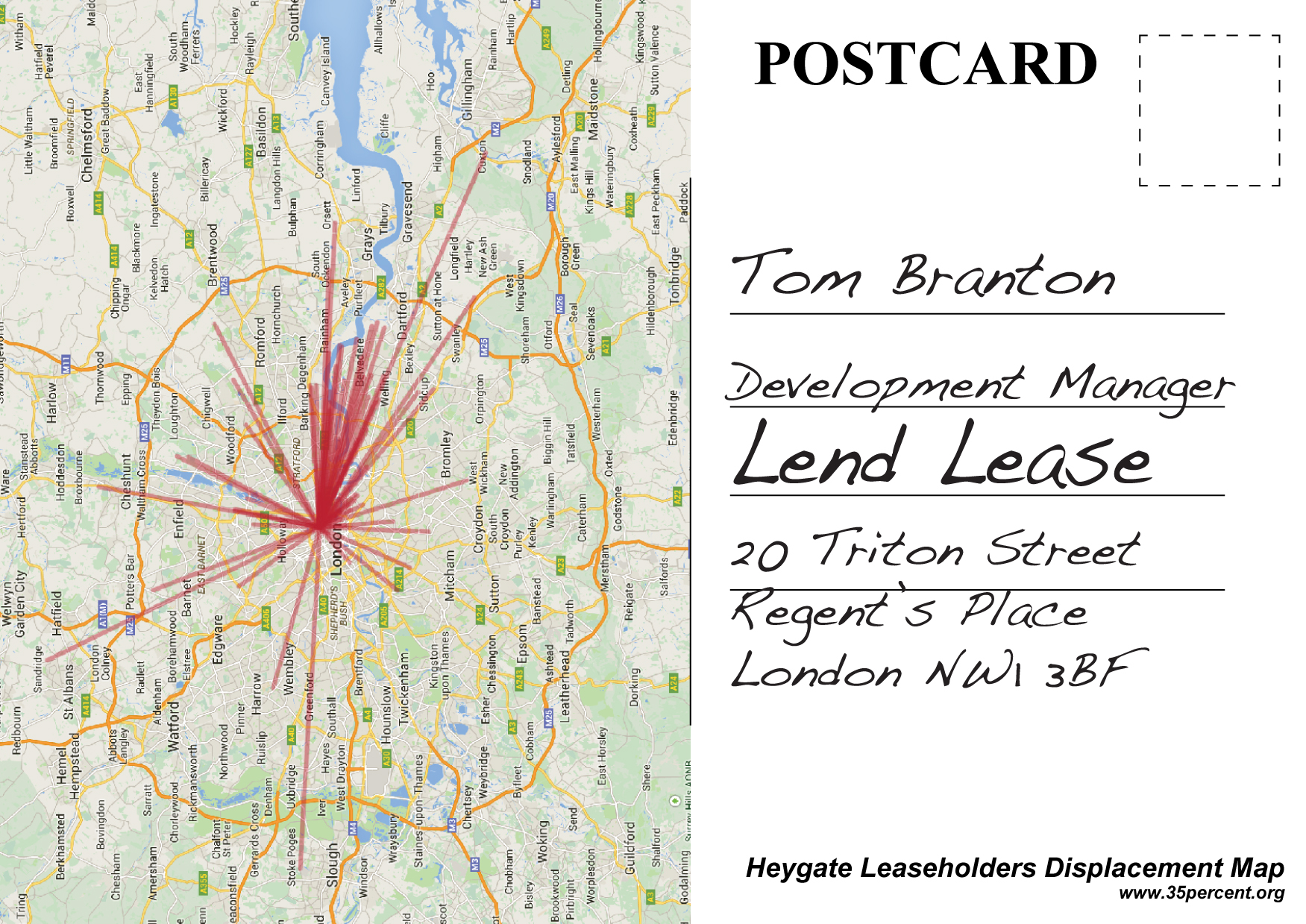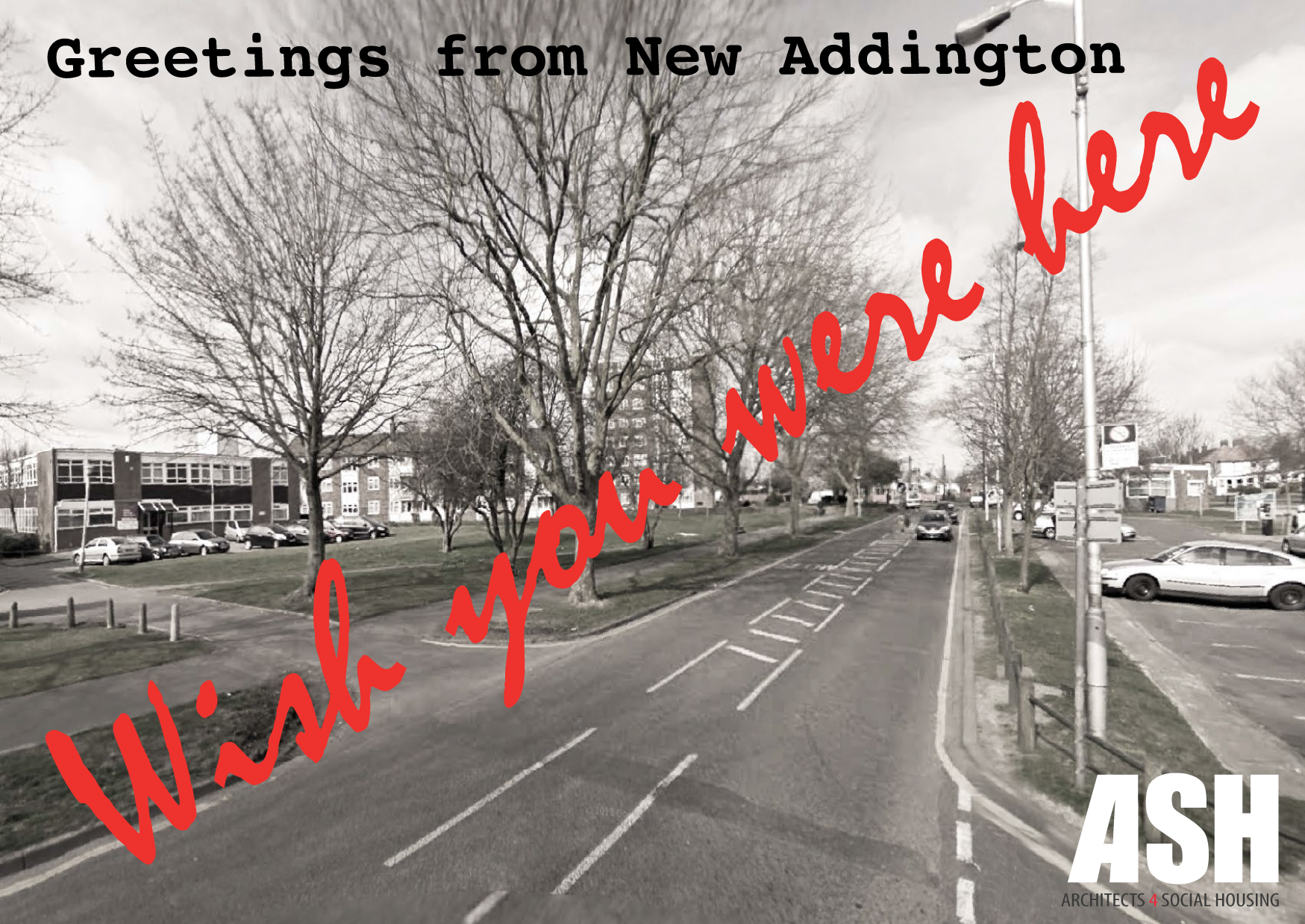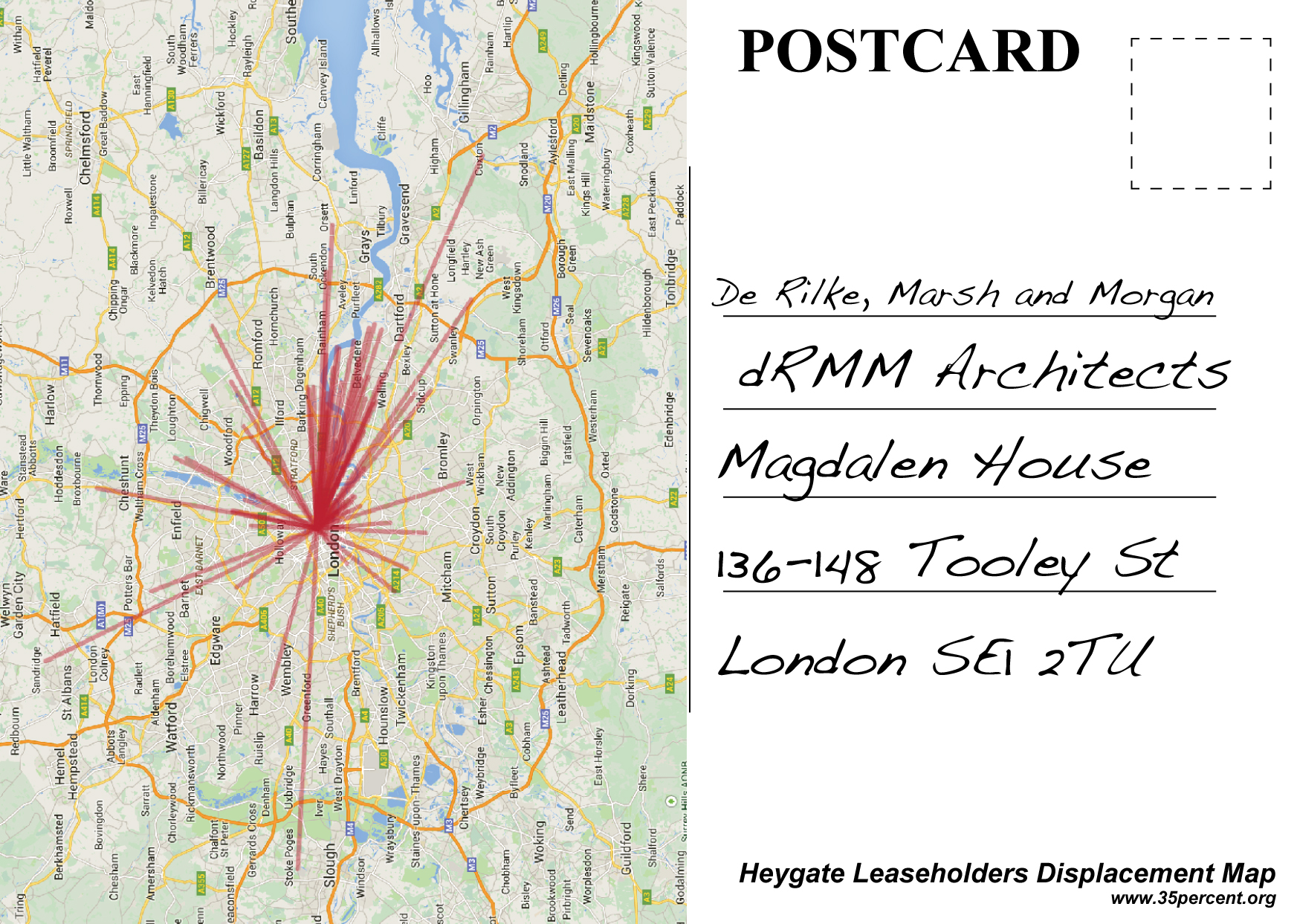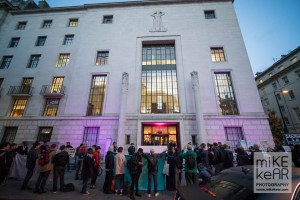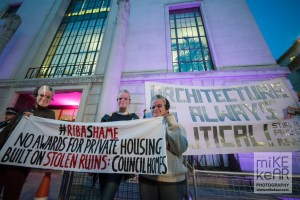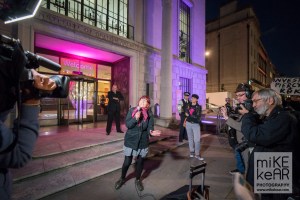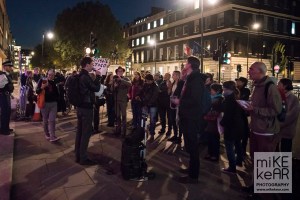
‘This year’s Stirling Prize list is safe. There is nothing that is going to upset anyone on there and it’s unlikely we’ll see protesters gathering outside Portland Place like last year, when Rogers Stirk Harbour + Partners’ NEO Bankside made the list.’
– Laura Mark, The Architects’ Journal
It’s that time of year again, when Britain’s most prestigious architectural prize is awarded, and the Royal Institute of British Architects has a chance to promote the values it wants to see guiding British architecture. The Stirling Prize is awarded for the building in the UK that has made ‘the greatest contribution to the evolution of architecture over the past year’. The short-list of 6 buildings was announced in July by the panel of 5 judges, one of whom, Michael Hussey, is a Director at Taylor Wimpey, the largest house-building company in the UK, which is sitting on enough land to build 184,730 homes, nearly a third of the 600,000 plots currently being land-banked by builders. Perhaps not surprisingly, then, but contrary to the predictions of The Architects’ Journal, Architects for Social Housing is once again calling a demonstration to protest against the RIBA’s nomination of dRMM Architects’ Trafalgar Place, the first development to be completed on the land where the demolished Heygate Estate once stood.
For the forty years of it existence, the Heygate Estate provided 1,214 council homes for more than 3,000 working-class residents in the London Borough of Southwark. Yet in 2002 the Liberal Democrat/Conservative Coalition Council announced the estate would be demolished. Demolition costs alone were estimated at £15 million, while a further £44m was spent on emptying the estate of residents, and £21.5 million spent on planning its redevelopment – a total of £80.5 million in a supposedly broke borough. In July 2010, multinational property developers Lend Lease were awarded the redevelopment contract by the newly elected Labour Council, and the 22-acre site in central London was sold for an astonishing £50 million, a total loss of £30.5 million to the Council. In comparison, a year later a neighbouring 1.5 acre site, one-fifteenth the size, sold for £40 million. In 2013, the last resident of the Heygate Estate was evicted from their home by Compulsory Purchase Order issued by Southwark Labour Council. It will surprise no-one who understands how these things work that the key councillors involved in the redevelopment deal are now working for Lend Lease.
According to Lend Lease’s masterplan, the 1,214 council homes on the former Heygate Estate will be replaced by 2,535 luxury homes, with the promise from Southwark Labour Council that 25 per cent will be ‘affordable’. Following a viability assessment by the real estate firm Savills, which is advising Labour Councils across London on their estate demolition programmes, a mere 82 homes have been promised for social rent in a borough with 18,000 people on the housing waiting list. According to the blog Heygate was Home, just 45 of the Heygate Estate’s 1034 tenanted households moved into the new homes they were promised.
This isn’t gentrification of an up-and-coming inner-city neighbourhood in need of private investment. This isn’t cash-trapped Labour Councils trying to find real solutions to the housing crisis under cuts to their budgets by Central Government. This isn’t developers cutting through red tape to build the homes that Londoners need. This is social cleansing for profit, and no architectural practice should have any part in it, let alone be awarded a prize for doing so.
Unfortunately, despite last year’s protest by ASH and the debate it initiated, it appears the RIBA has still not understood the duties of the architectural profession and the stance it should be taking on the social cleansing of London through the Trojan Horse of estate demolition schemes. The recent RIBA publication on the Ethics of Estate Regeneration, while a welcome attempt to engage with these issues, failed to grasp the social consequences of this shameful episode in the history of British architecture. That the RIBA has chosen to nominate a development on the former Heygate Estate – perhaps the worst example to date of estate demolition in London, a bi-word for social cleansing, council corruption and private profiteering – shows just how distant their ivory tower is from the harsh reality of housing in the UK today.
Built on the ruins of the demolished council estate, Trafalgar Place, the first phase of Lend Lease’s £1.5 billion Elephant & Castle redevelopment, comprises 235 so-called ‘high-quality’ homes, 52 of which are so-called ‘affordable housing’, which means for sale or rent at 80 per cent of market rate. To get an idea of what market rate is for ‘high-quality’ homes in Southwark, in today’s Zoopla a 2-bedroom flat in Trafalgar Place is on sale for £725,000. In contrast, owners of a 4-bedroom council flat on the former Heygate Estate were offered £190,000 in compensation for their demolished home. A disgraceful 8 homes in Trafalgar Place have been allocated for social rent. The site on which this property speculator’s investment opportunity is built, and which is being advertised on Asian real estate markets, was previously occupied by the demolished Wyngrave House, which provided 104 council homes for the local community.
In recognition of which – of both the social violence that is Trafalgar Place and of the social dereliction of its nomination by the Royal Institute for British Architects – Architects for Social Housing is delighted to announce that this year’s O. J. Simpson Prize, awarded for ‘Getting Away With Murder’, has been won by dRMM Architects for Trafalgar Place.
ASH will be awarding the O. J. Simpson prize to dRMM Architects at this year’s RIBA Stirling Prize Ceremony, outside 66 Portland Place, on Thursday, 6 October, 2016. Reception begins at 6pm, with the award announced between 7 and 8pm, so arrive early if you don’t want to miss the guests paying £235 (+VAT) for a ticket on the way in. Please join us.
Postcards
Dear Tom
As Southwark Council’s lead officer responsible for the procurement of Lend Lease as regeneration partner on the Heygate Estate, and who authored the report to Cabinet recommending the signing of the regeneration agreement in July 2010, how do you account for the £30.5 million loss the council made on the deal?
Why did Southwark Labour Council sell the 22-acre site on which the Heygate Estate was built to Lend Lease for £50 million, when a neighbouring 1.5 acre, one-fifteenth of the size, sold for £40 million a year later?
Do you consider the fact that you left Southwark Labour Council in January 2011 to work for Lend Lease, where until May 2016 you were Development Manager for the Elephant & Castle project, evidence of a conflict of interest that should be investigated by the Fraud Squad?
Do you think that Trafalgar Place, the first completed phase of the Elephant & Castle Project, where a 2-bedroom apartment is selling for £725,000, is providing solutions or contributing to London’s housing crisis?
Yours sincerely
Architects for Social Housing
P.S. Wish you were here
Dear Mark
As Cabinet Member for Regeneration and New Homes in Southwark Labour Council, you called the Secretary of State’s recent decision to reject the compulsory purchase order on the Aylesbury Estate on the grounds it violated residents’ human rights, ‘extremely disappointing’. Are you disappointed not to violate residents’ human rights?
Do you consider that challenging this decision by a Tory Minister in the High Court in order to demolish the homes of the tenants whose rents pay your salaries is an ethical use of funds by Southwark Labour Council?
Why was the report commissioned by Southwark Labour Council into the cost of refurbishment of the Aylesbury Estate not submitted to the Executive Committee in September 2005, and why do you continue to assert that the estate’s refurbishment is not affordable when that report found it to be 58 per cent of the cost of demolition and redevelopment?
Do you acknowledge a conflict of interest in the fact that, in addition to being responsible for signing off the demolition of council estates in Southwark and the social cleansing of their residents from the borough, you are also a Senior Associate at Regis Homes, a private company that specialises in land acquisition and real estate developments in London?
Yours sincerely
Architects for Social Housing
P.S. Wish you were here
G’day Dan
As Chief Executive Officer of International Operations at Lend Lease with an annual salary of £2.5 million, how did you get real estate firm Savills to convince Southwark Labour Council that out of the 2,535 luxury apartments your company is building in the £1.5 billion redevelopment of the Heygate Estate, you could only afford to build 82 for social rent?
Does the fact that Tom Branton, Southwark Council’s lead officer responsible for the procurement of Lend Lease as regeneration partner in July 2010, left the Council in January 2011 to work for Lend Lease as Development Manager for the Elephant & Castle project;
And the fact that Kura Perkins, Southwark Council’s Communications Manager on the Elephant & Castle project, left in 2006 to work for Lend Lease as its Communications Manager;
And the fact that Paul Dimoldenberg, Senior Research Officer at Southwark Council, left to set up a company that deals with Lend Lease’s public relations on all its major developments;
And the fact that Julie Greer, Southwark Council’s Design Manager for the Elephant & Castle masterplan, left in 2007 to work on Lend Lease’s Olympic Village development;
And the fact that Chris Horn, the lead council officer who advised on Lend Lease’s selection as development partner, now works for a company that advised on Lend Lease’s Greenwich Peninsula development;
And the fact that Peter John, the current Leader of Southwark Labour Council, who signed the Elephant & Castle deal with Lend Lease in July 2010, accepted £3,200 worth of tickets to the Olympic opening ceremony and an all-expenses-paid £1,250 trip to the MIPIM property fair in Cannes from Lend Lease;
Did any of these facts contribute to the fact that in July 2010, Southwark Labour Council sold the land the Heygate Estate stood on to Lend Lease for £50 million, roughly one-twelfth of its market value?
Do you think it is right that an international property developer based in Sydney, Australia, has evicted over 3,000 residents from their homes in London, England, in order to build luxury apartments priced at £725,000 for a 2-bedroom apartment in Trafalgar Place, and £1,495,000 for a 3-bedroom apartment in One The Elephant, while leaseholders on the Heygate Estate were offered £190,000 for a 4-bedroom flat, and have consequently been forced to the outer boroughs of their city, for the profits of Lend Lease and its shareholders, which in August 2016 announced revenue growth of 13.6 per cent to £11.83 billion, with net profits rising by nearly 13 per cent to £547 million?
Yours sincerely
Architects for Social Housing
P.S. Wish you were here
Dear Ben
What is your response to the Secretary of State’s judgement that, under Article 8 of the European Convention on Human Rights, the Aylesbury Estate regeneration on which your company, HTA Design, is the lead architectural practice violates residents’ ‘right to respect for their home’?
Do you consider the Secretary of State’s ruling that, under the Equality Act 2010, the demolition and redevelopment of the Aylesbury Estate discriminates against residents according to their age and race, sufficient to discontinue your so far unshakeable support for this scheme?
In November 2015 you wrote:
‘Although HTA Design was not involved in the process that led to the decision to redevelop the Aylesbury Estate, we have absolutely no reason to doubt the thoroughness of the process that gave rise to the Area Action Plan, which was adopted by Southwark Council and the residents of the estate as the basis for the redevelopment brief.’
Given that, in 2001, 73 per cent of residents on a 76 per cent turn out voted against the demolition of the Aylesbury Estate and for its refurbishment;
And given the revelations at the Public Inquiry last year that in 2005 Southwark Labour Council deliberately suppressed the report on the option to refurbish the Aylesbury Estate because it concluded that it was 58 per cent the cost of redevelopment, and then artificially raised the cost of doing so by £148.9 million for external works that were costed at £24.8 million;
And given that in 2009 Aylesbury Tenants and Leaseholders First made a submission to the Government Inspector on the ‘systematic failings of the Aylesbury Area Action Plan consultation process’;
Do you now have sufficient reasons to doubt?
Do you intend to honour your existing contract with Southwark Labour Council and Notting Hill Housing Trust and continue to discriminate against, violate the human rights and ignore the wishes of residents on the Aylesbury Estate?
And do you think it right that the Royal Institute of British Architects, of which you are the President Elect, has nominated Trafalgar Place, the first completed site on the adjoining Heygate Estate regeneration, for the 2016 Stirling Prize for violating the same human rights, discriminating against on the same basis, and ignoring the wishes of the 3,000 residents that once lived there?
Yours sincerely
Architects for Social Housing
P.S. Wish you were here
Dear Alex, Sadie and Philip
On your website you write: ‘dRMM Architects’ strength has been our ability to reflect on the bigger picture, discovering through local consultation what residents want’. Do you consider the demolition of the 1,200 council homes of the Heygate Estate to be part of ‘the bigger picture’ and believe the eviction of its 3,000 residents from the borough to be ‘what they want’?
You also write: ‘As London seeks to cope with its chronic housing shortage and improve inner-city living, we believe that an awareness of the effects of the built environment at a local level should be paramount.’ Do you think the demolition of the 104 council homes of the former Wyngrave House and their replacement with 235 luxury apartments selling at £725,000 for a 2-bedroom unit is reducing the housing shortage in London and improving inner-city living for those who cannot afford such prices?
In nominating your practice for this year’s Stirling Prize, the RIBA described Trafalgar Place as ‘an outstanding site-plan which connects the development to the local community.’ How do on-site security guards, gated access, anti-homeless spikes and CCTV cameras connect Trafalgar Place to a local community that cannot afford to buy or rent its luxury housing?
Standard no. 5 of the ARB Architects Standards of Professional Conduct and Practice says: ‘As an architect you are expected to consider the wider impact of your work’. In addition to the evicted residents and demolished council housing on the site of Trafalgar Place, what impact do you think your work will have on the social cleansing of the Elephant & Castle area by Southwark Labour Council?
Yours sincerely
Architects for Social Housing
P.S. Wish you were here
Ben Derbyshire Foot in Mouth Award
ASH is pleased to announce this inaugural award for the most arrogant, misinformed and dismissive comment by the President elect of the RIBA, which will be decided by democratic vote this evening as part of the Stirling Prize protest.
And the nominations are:
1. ‘It is essential that we are clear about the objective of estate regeneration: is it to improve the lives of those who live on and around existing estates, or is it to make more effective use of public land to help solve the housing crisis by creating additional homes and widening access to home ownership?’
– Altered Estates: How to reconcile competing interests in estate regeneration (2016)
2. ‘Although HTA Design was not involved in the process that led to the decision to redevelop the Aylesbury Estate, we have absolutely no reason to doubt the thoroughness of the process that gave rise to the Area Action Plan, which was adopted by Southwark Council and the residents of the estate as the basis for the redevelopment brief.’
– The Architects’ Journal (November, 2015)
3. ‘Whilst many (me included) are concerned that current housing and planning policies do not serve the ambition to create mixed neighbourhoods particularly well, not everyone believes that public money should be used to subsidise families to live in areas they could not otherwise afford to.’
– The Architects’ Journal (September, 2016)
4. ‘The one key issue facing the profession at the moment is the extent to which we are valued by society in terms of our social, cultural and economic value.’
– The Architects’ Journal (June 2016)
5. ‘Well, thank you very much for your point of view. Would you be so kind as to leave now?’
– Response to Fight for Aylesbury occupation of the Camden offices of HTA Design during a meeting with Mae, Hawkins\Brown and Duggan Morris Architects (May 2015)
By an overwhelming majority on the night, quote number 3 was voted the Winner of the 2016 Ben Derbyshire Foot in Mouth Award. The often repeated lie that council housing is subsidised by public money is a myth propagated by the property developers and councils that want the land they are built on, and it doesn’t bode well for the future of the RIBA as an institution to hear it repeated from the mouth of its future President. What stops the families Ben Derbyshire so loftily dismisses from their neighbourhoods from being able to afford to live there is precisely the demolition of the council estates they have called home for decades and their replacement with the luxury apartments the RIBA has seen fit to nominate for this year’s Stirling Prize.
Photographs
Press Reactions
‘Should ethical and political considerations affect judgements on architecture? Architecture is by its nature political, so these questions deserve to be asked. But should they really affect the jury’s deliberations? Judges are tasked only with weighing up questions of design quality, rather than considering tricky issues about where a building’s funding has come from, or what effect a project might have on an area’s existing community.’
– Will Hurst, editor, The Architects’ Journal (29 September, 2016)
‘Architects for Social Housing have long opposed the multi-million-pound redevelopment of the Heygate Estate in Walworth. As Architects for Social Housing highlight, someone is making gigantic profits through these schemes, in a crass transfer of public property to private interests.’
– Inside Croydon, Architects plan protest against ‘social cleansing for profit’ (3 October, 2016)
‘Ben Derbyshire warns his colleagues against the “mistake of attempting to stretch beyond their political legitimacy and reach” and that the RIBA “is neither the House of Commons nor the United Nations”. We take this to mean that considerations such as the demolition of council estates and the forced removal of estate residents should play no part in the award’s deliberations. This is hopelessly naïve, to put it kindly. The Stirling nomination of Trafalgar Places casts estate regenerations generally in a good light and it invests the Heygate redevelopment in particular with prestige, a prestige that will no doubt translate into higher sales prices, should it actually win the prize.’
– 35% Campaign (4 October, 2016)
‘If the RIBA considers dRMM and Lendlease’s emblem of professional compromise and social violence to be “an example for future housing developments”, it is time to respond combatively. To fight back but also forwards. How much more evacuated of meaning – never mind justice – can such a model of “place-making” be? It is astonishing that the architectural profession is happy to serve global corporate developers while ignoring their responsibility for what existed beforehand and the processes which delivered up a convenient tabula rasa.’
– Guy Mannes-Abbott, The Architectural Review (5 October, 2016)
‘In the 1960s, when I worked in Southwark and the Heygate scheme was on the drawing board, about 50 per cent of architects worked in the public sector, on housing programmes aimed at giving decent dwelling to families like the one featured in the Ken Loach film Cathy Come Home. Now a substantial number of architects are facilitating the expulsion from Central London of the contemporary equivalent of that “Cathy”. A judgment has to be made, not just on the quality of a building, but whether it contributes to the Common Weal, or its opposite. ASH have demonstrated that there are other ways to practice architecture and maintain professional integrity.’
– Kate Macintosh, statement in support of ASH’s Stirling Prize Protest (5 October, 2016)
‘The obliteration of the Modernist social project fundamentally calls into question what kind of city we want and whether the power still exists to make it viable. Slipping through unremarked, London’s hollowing-out and banlieuisation is a pernicious, anti-social reductivism that sees the price of everything and the value of nothing.’
– Catherine Slessor, The Architects’ Journal (6 October, 2016)
‘Piers Corbyn, the brother of the Labour Party leader Jeremy Corbyn, was among the activists who gathered in central London this week to protest at the Royal Institute for British Architects’ Stirling Prize awards dinner, over the organisation’s support for schemes which have seen the transfer of billions of pounds of public land and assets to private interests.’
– Inside Croydon (9 October, 2016)
‘The Stirling Prize party itself was a stranger-than-fiction affair. There were speeches, canapés and genuine enthusiasm for Caruso St John as a worthy winner, but also security brawls, with protesters shouting about social cleansing and gentrification. On several occasions demonstrators breached the perimeter, running towards the Jarvis Hall in balaclavas or climbing onto the rooftop outside the reception to press a sign up against a window. The fracas was greeted with discomfited bemusement and grim acceptance that the estate regeneration programme has meant architects are increasingly engaged in socio-politically loaded projects – architects who work in this sector must be prepared to take the heat.’
– Christine Murray, The Architects’ Journal (11 October, 2016)
‘Architecture’s great problem is the gap between the visionary and the grubby compromise of reality. The architect’s trajectory is disappointment. But there is also activism, a halfway house that manages to blend idealism with realism, and a position that ought to be the default setting of the profession.’
– Edwin Heathcote, Icon (13 October, 2016)
– Owen Sheppard, Southwark News (13 October, 2016)
‘The protesters returned last week, provoked by the Stirling Prize nomination of dRMM’s Trafalgar Place – the first phase of the contentious regeneration of the Heygate Estate in London. Armed with masks of incoming president Ben Derbyshire (who also heads up HTA, masterplanner of the controversial Aylesbury Estate overhaul) as well as placards, megaphones and a catchy chant, the campaigners took their remonstrations to new levels.’
– The Architects’ Journal (14 October, 2016)
‘Anyone implicated in social cleansing like dRMM or HTA Architects will not be allowed to rest easy behind police and security protection. Why? Because these are our homes and our communities they are playing with!’
Architects for Social Housing

Architects for Social Housing is a Community Interest Company (no. 10383452). Although we do occasionally receive minimal fees for our design work, the majority of what we do is unpaid and we have no source of public funding. If you would like to support our work, you can make a donation through PayPal:

